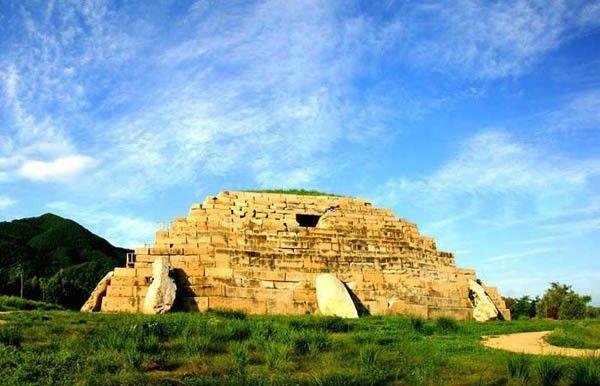Citadel and tomb Cao Cu Ly - Cultural heritage of China
Unesco's Scientific, Educational and Cultural Organization recognized the Citadel and Tomb of Cao Cu Ly as a World Cultural Heritage in 2004.
Cao Cu Ly - Chinese cultural heritage
Cao Cu Ly's citadel and tomb consist of two parts, the ruins of an ancient citadel, and a complex of ancient tombs built in the 1st century, the 2nd century BC in the capital of the Koguryo kingdom - a king Mighty ancient nation in Northeast China and the Korean peninsula.
Although these are the remains of Koreans , they are a legacy in China because the ancient capital of Cao Cu Ly was occupied by China. Korea and the Democratic People's Republic of Korea have made many efforts to make the world understand that the historical, cultural and anthropological relics related to Korea.
Both the Citadel and Cao Cu Ly Tomb are a monumental architectural complex in which there are 40 tombs, 14 temples worshiping kings, the remaining 26 are of noble mandarins.

Cao Cu Ly's name is also called: Cao Cau Ly, Cao Cau Ly, Co Cao Ly and Koguryeo are all right. This was a dynasty in the north of the Korean peninsula and Manchuria.
According to the records of the Cap Ly era, Goguryeo was founded in 37 BC by Jumong. However, there is an opinion that this dynasty was founded in the 2nd century BC. Other emirates in the territory of Cao Gong included Phu Du, Oc Loi and Dong Ue, all later annexed by Cao Ke Ly.
Cao Cao Ly has repeatedly resisted invaders from China. In 589, Sui Van De of the Sui family took 30 thousand Cao Cao Ly invaders but was defeated, and withdrew to China. Next, in the years 612, 613, 614, the Sui continued to bring Cao Cao Ly invaders but failed. When Tang replaced Tuy's house, taking advantage of the unstable situation in China, Cao Cau Ly built the school from northeastern Phu Du to Bot Hai against the Tang invaders. Later, Cao Ke Ly allied with Baekje to attack Tan La, who asked for Tang's aid.
The Tang army gradually collaborated with Silla to destroy Baekje, isolating Gao Zheng. By 666, Cao Co Ly's internal conflict was in conflict, the country became increasingly weak, destroyed by Tang and Tan La in 668.

Cao Chu Mong Ko Jumong is the first king of the Cao Toc Ly dynasty and is the hero of the ancient country of Korea. He was crowned in the middle of the 3rd century with the date of the Emperor Minh Thanh. He is also known as Chu Mo Vuong (King Chu Mo). In the Three Kingdoms history (Samguk Sagi) and the Three Kingdoms (Samguk Yusa), he is called Zhou Meng, with them being Cao.
From the very beginning, the emperor had built the first capital of the kingdom in Guonei. 30 years later, the kingdom's main citadel was passed to Wandu Mountain. By 427 again moved to Pyonyan, now the capital of the Democratic People's Republic of Korea.
Guonei and Wandu Mountain have been the economic, political, and cultural centers of Cao Ly for hundreds of years. Until Guonei was destroyed in 197. In 209, the city of Wandu Mountain was completed construction. Both of these ancient cities were greatly damaged through wars.
After moving to Pyongyang, the two cities were almost abandoned for a long time. Until 1902 began to receive attention and restoration. However, it was not until 1999-2002 that the new restoration was completed. The capital and tomb of Cao Cu Ly were recognized by Unesco under the criteria (i), (ii), (iii), (iv), (v).

Criterion (i) : Tombs with beautiful architecture are a testament to the creativity of the ancient people.
Criterion (ii) : The Citadel and Tomb of Cao Cu Ly are examples of the first mountain city of China, where many cultures of the surrounding areas are gathered. Besides the paintings left on the walls or carved in the grave show the skillful ability of the old craftsmen.
Criterion (iii) : Citadel and tomb of Cao Cu Ly are the remaining proof of a vanished civilization.
Criterion (iv) : The ancient citadel of Guonei and Wandu Mountain greatly influenced the construction of the capital later in the Cao Cu Ly dynasty.
Criterion (v) : Citadel and tomb of Cao Cu Ly are the perfect combination between human creativity and nature.









- Cultural landscape of Bam - World Cultural Heritage in Iran
- Tomb of Qin Shihuang - China
- Lijiang town
- Ancient Citadel of Binh Dao - China
- Acre ancient citadel - World cultural heritage in Israel
- Hwaseong ancient citadel in Suwon
- Di Hoa Vien - World Cultural Heritage in China
- Koguryo tomb complex - World cultural heritage in Korea
- Bungada tomb area in Kasubi
- BaKu ancient citadel, Shirvanshah Palace and Maiden tower
- Secrets - World Cultural Heritage in China
- Pasargadae - World Cultural Heritage in Iran
 Suzhou classic bonsai garden - China
Suzhou classic bonsai garden - China Chau Nguyen Dynasty
Chau Nguyen Dynasty Thai Son Mountain - World Wonder
Thai Son Mountain - World Wonder Ancient villages of Shirakawa-go and Gokayama
Ancient villages of Shirakawa-go and Gokayama